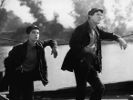Eye For Film >> Movies >> Steamboat Bill, Jr. (1928) Film Review
Steamboat Bill, Jr.
Reviewed by: Jennie Kermode

One of the most consistently entertaining of Buster Keaton's outings, Steamboat Bill, Jr. packs in more stunts in 70 minutes than most action franchises have in total, and does so with panache. Its slapstick humour is tempered by the self-effacing charm of its hero, and consistent inventiveness means a superficially simple plot is full of surprises.
Ernest Torrence is Steamboat Bill, about to see his son for the first time in a decade or more, boasting about how big and strong the lad will be by now. Young Willie (Buster Keaton), a skinny youth with a beret, a ukelele and eyeliner, is never going to live up to this ideal, and none of his father's efforts seem to change him. Most infuriatingly, he's in love with Kitty (Marion Byron in her debut role), the daughter of Bill's bitter rival, JJ King (Tom McGuire). King owns most of the town and a glorious, palatial modern riverboat. Bill's riverboat has seen better days; as he fights (sometimes literally) to keep his business going, has his son any hope of winning him over?

More tightly scripted that many Keaton showcases, the film does a lot with this slender premise and throws in a climactic cyclone for good measure. It makes a lot out of simple sequences - a jailbreak, a visit to a hat shop - which last longer that you might expect, yet remain entertaining. They work, in part, because they're drawing on established cinematic language and playing with audience expectations, an interesting phenomenon in a film made this early. Not that one would guess its age from the quality of the print. It looks fantastic, enabling present day viewers to appreciate the evocative cinematography and the subtler visual jokes hidden among the slapstick. During the cyclone sequence it veers into surrealism, building in old theatrical jokes which extend into the wider world as façades start dropping off buildings, making everything look like a set. The set itself is literally breaking down as a rolling tide threatens to sweep our heroes out into the audience.
Gripping as this is today, it's worth taking the time to consider how it must have impacted viewers on first release. Powerful wind machines were relatively new and Keaton, as always, immediately saw the potential of the new technology, constructing some fantastic scenes around it. He designed all the stunts himself, including dropping a two ton building so that it missed him by inches, and never broke character or showed the slightest evidence of fear, despite having broken his neck on a previous film. This generates a tension that's rarely present in modern films, a the same time as going all out for comedy.
Steamboat Bill, Jr. was one of the last films from this period over which Keaton had creative control, and although it's not among his most famous, it's one of the best. Silent films may not pack in big crowds today, but you'd be a fool to miss the chance to see this on the big screen.
Reviewed on: 15 Sep 2015
















